what can cause a layer of glass beads to cover the ground
Sometimes art terms tin be disruptive – some words mean more than than one matter, or one product can be called two or three dissimilar names. A case in point is the words that nosotros use for the materials and methods used to prepare surfaces for painting.
Although information technology is possible to paint in oil or acrylic on an unprimed support, y'all volition find that there are some difficulties with paint treatment if yous paint directly on raw canvas, newspaper or forest. With acrylic pigment, canvas tin can repel water then the pigment beads up and doesn't flow. With oil paint, canvas can soak up oil and produce halos of it around painted areas, or go out the oil pigment crumbly and under-bound. With either paint, the weave could be more visible or bumpy than you want, or the colour of linen may be too dark; paper can absorb oil or buckle from h2o because it is likewise lightweight; wood can absorb pigment unevenly in the stripes of the grain or assimilation of water can crusade information technology to swell or split. Then there are treatments for these surfaces that are usually used to make them easier to paint on. By using size to seal the surface followed past a primer, gesso or footing, an creative person tin create a surface that allows easier, more controlled painting. A second consideration is that these treatments also help create a more than stable surface then the painting remains unchanged for longer. For permanent paintings you lot should exist as concerned with the proper preparation of the foundation layers of the painting that are perhaps not visible (the support, the size and the ground) as with the layers that you practice encounter (the pigment, mediums and varnish).
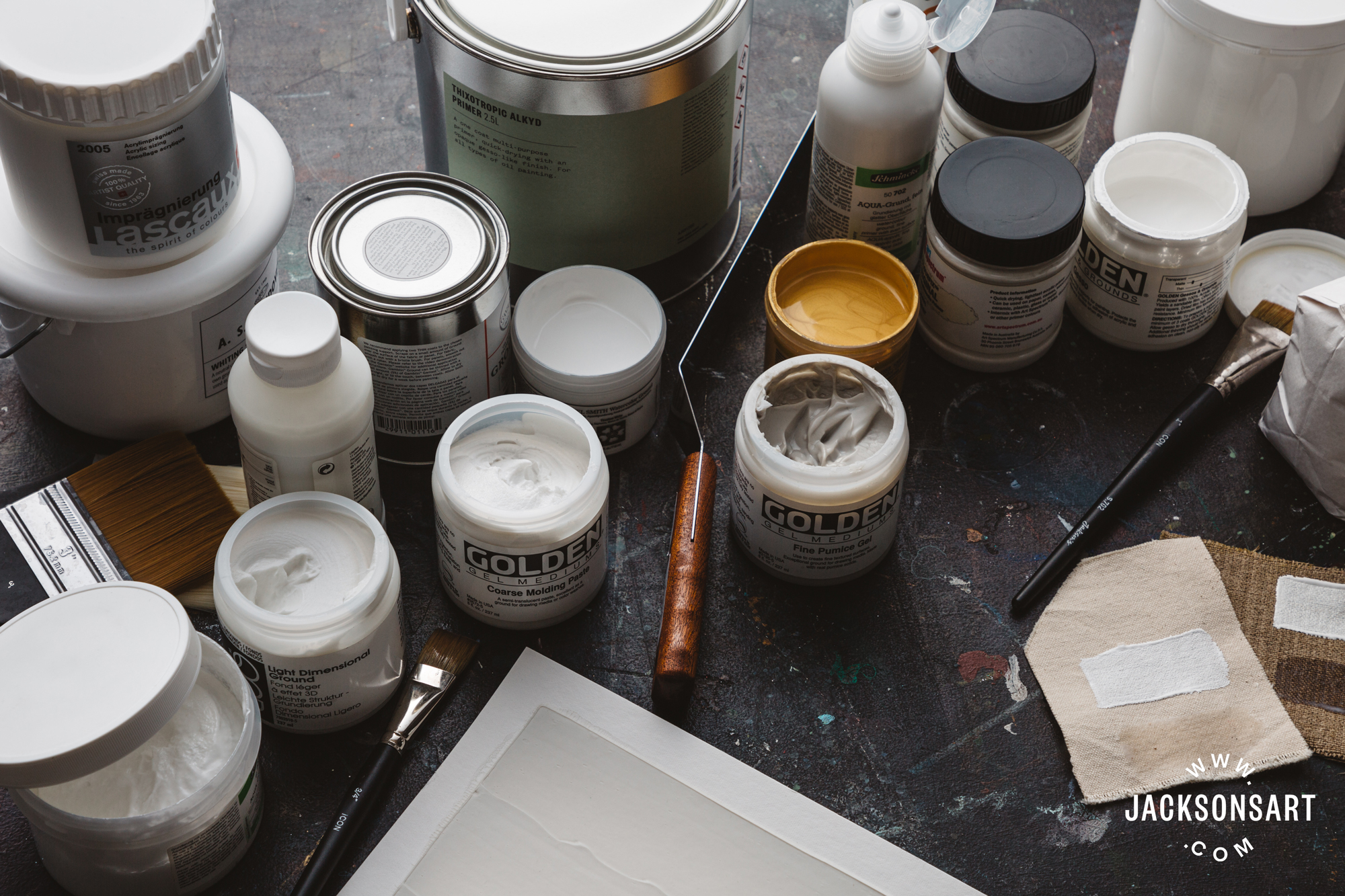
Size, Primer, Gesso and Footing
Size, primer, gesso and ground are terms for the parts of the surface of a painting between the support – sail, wood or newspaper – and the paint. Sizing is pretty clear – information technology is the beginning step of sealing the support. But at that place is some confusion almost the other iii terms – primer, gesso and footing – which are often used interchangeably, though not always correctly. Materials manufacturers are not consistent with naming, which tin add to the confusion. Though some of these terms also apply to surfaces for works in dry media like pencil and pastel, and to other painting media like watercolour, egg tempera and encaustic, I am generally focussing on how they are used in oil and acrylic painting considering there is a wider range of choices available, and then there is a bit more confusion. And the other media can be extrapolated from this data.
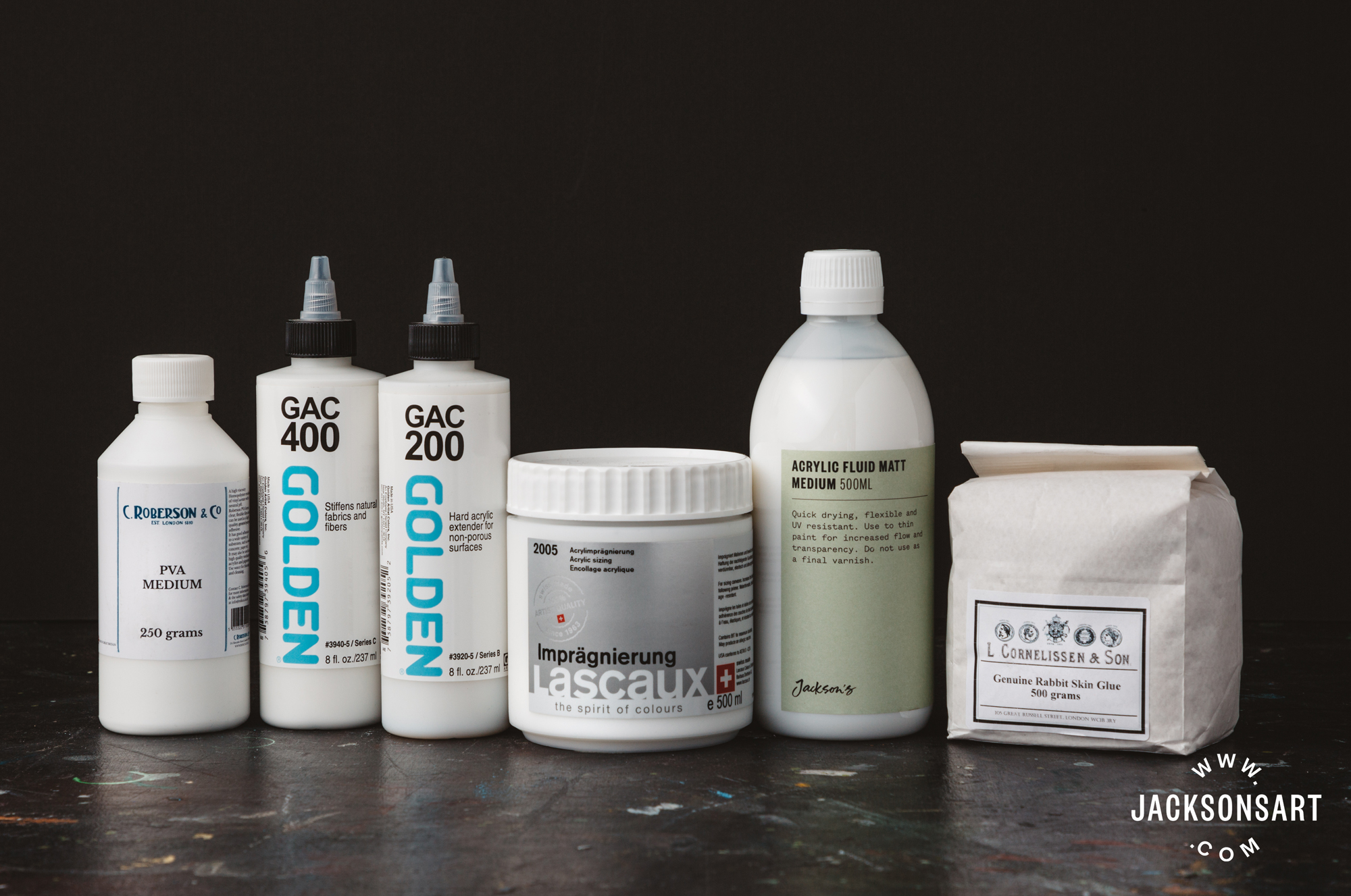
Sizing agents include: acrylic size, acrylic polymer used with or without acrylic material stiffening medium, acrylic matt medium, PVA size, and rabbit skin glue.
Size (sealant)
A size is a glue that seals the surface to reduce absorption. The surface sizing on watercolour paper helps watercolour and acrylic paint sit brightly on the surface rather than be absorbed into the fibres where information technology will look tedious and washed out, and on canvas it prevents oil paint coming into contact with the fibres which would slowly exist damaged past the oil. Size is as well often a stiffener for canvas, then information technology will wobble less. Woods panels do non demand to be sealed from oil for longevity but sizing gives a meliorate surface for oil grounds or genuine gesso grounds to sit down on by evening out the absorbency of the wood which would otherwise take dissimilar absorbencies betwixt the grain lines and the wood betwixt them. Sealing the wood besides prevents moisture from drawing up colour, acids, glues, etc. from the wood into your gesso.
A size can exist made from acrylic polymer, PVA, acrylic and casein, or fauna gelatine. Be aware that in that location are over 50 different types of formulations of PVA (Polyvinyl Acetate) and just a few are of a expert enough quality to make permanent paintings because they accept depression acidity, retain flexibility, and have depression colour change. Look for pH neutral, sometimes called acid-free, PVA. PVA not made specifically for artists volition deteriorate and is to exist avoided. We stock sail that is partially prepared, information technology is sized with rabbit skin glue set up for application of an oil ground or another coat of mucilage if yous wish it to be clear coated. Yous tin read more about sizes in Rabbit Peel Glue: Preparation, Uses and Alternatives.

This shows that oil has slowly seeped out of the pigment and created a halo on this un-primed newspaper.
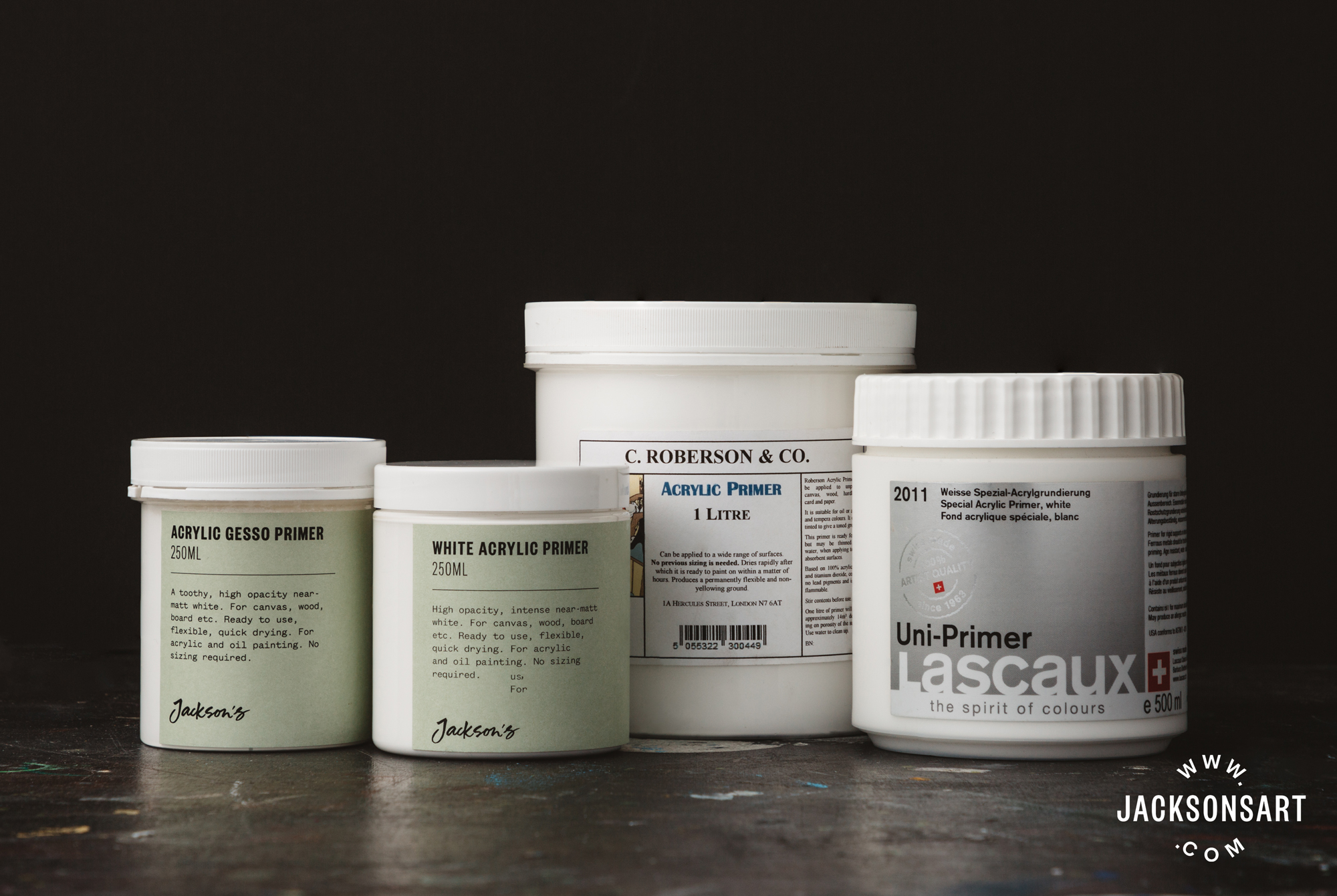
These are just a few of the wide range of available acrylic primer/grounds.
Primer
A primer is a glue that sticks well to your surface, amend than your paint would. Then when your paint is applied, it sticks well to the primer, and then then your paint is well adhered to the surface through a middleman. If your pigment isn't adhered well it could come off a bit when cleaned, rubbed or scratched, it could flake off after it has dried, or delaminate and come up of in pieces when information technology undergoes a sudden temperature shift (the change from storage in a cool room to sitting in the hot sun waiting to be loaded into a van, for instance), is removed from the stretcher and rolled for storage, or if information technology gets a sudden knock from existence dropped.
An acrylic dispersion ground will usually be chosen either acrylic gesso or acrylic primer and can fulfil the role of a size, primer and ground all in one. It seals the surface, it sticks to the surface even better than acrylic paint would and it provides a footing to pigment on. It can be applied straight to a support without the need for a prior application of size. Almost ready-prepared stretched canvases are Universal Primed, meaning that they have an acrylic basis and then you tin pigment on them with oil or acrylic pigment. There are besides primers for item surfaces, such as the Turner Glass Primer or Forest Primer for acrylic pigment. The primer sticks to the drinking glass and then acrylic pigment sticks to the primer, where acrylic paint would not have stuck to the glass directly, it would peel off.
The verb virtually used for the action of preparing surfaces is 'to prime'. "I spent the weekend priming panels so at present I have enough surfaces for the next six months of painting!" Simply 'to gesso' is also used. "I have to finish gessoing my sheet today because I need to offset painting on information technology next week."
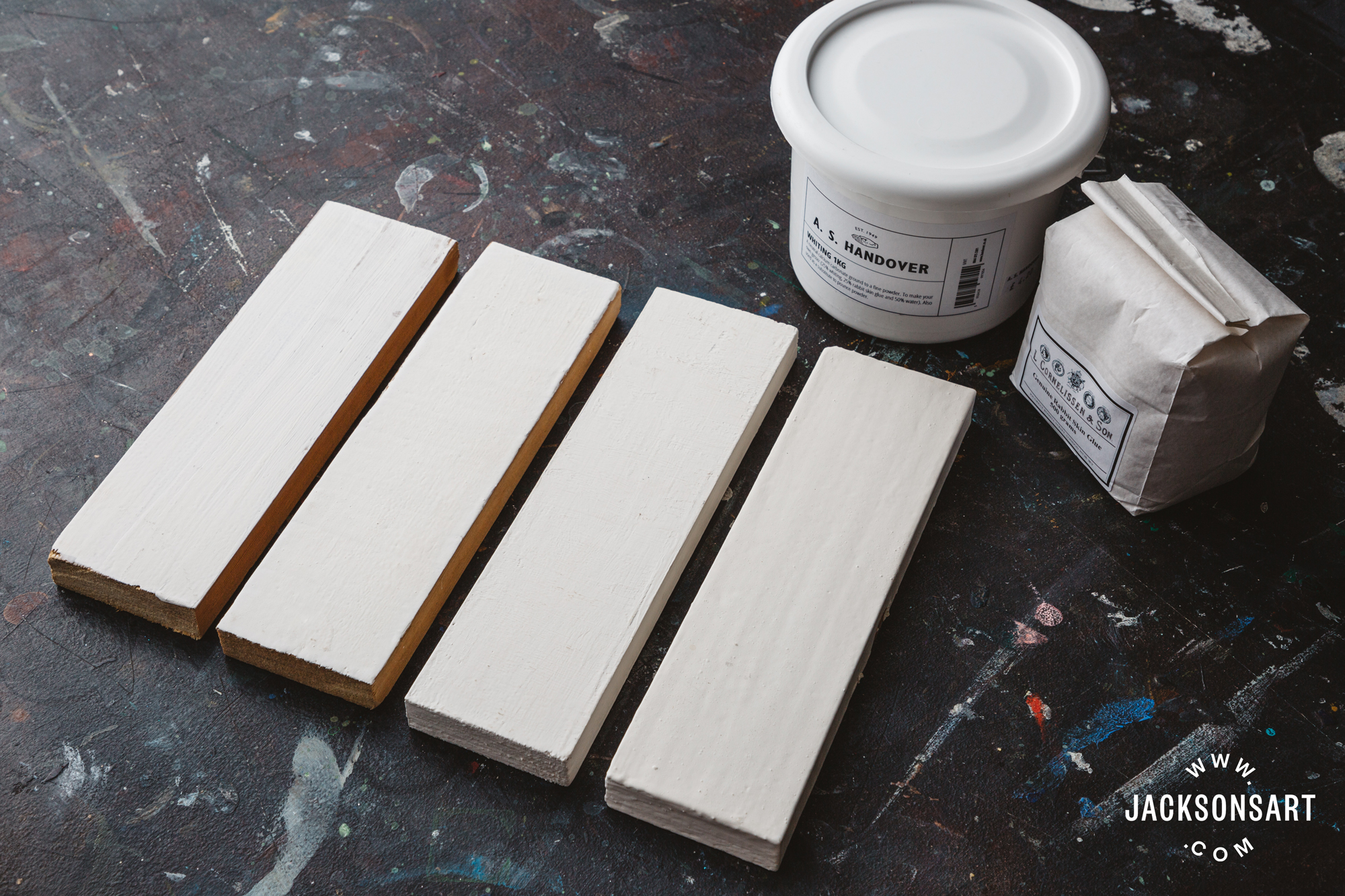
Genuine Gesso is fabricated of warmed fauna glue and whiting. Shown here are four test pieces of wood with increasingly more than coats of gesso right to left.
Gesso
The term 'gesso' is often used for all types of primers and grounds, considering information technology was the original. But technically information technology but refers to the traditional mixture of hot animate being glue and gypsum or chalk, applied in many sparse layers to wooden panels while warm. It is pronounced with a soft one thousand like gypsy or George, from the Italian for gypsum, a major component. Acrylic primers were created to be similar to traditional gesso. Because of the confusion of and so many people calling acrylic primers 'gesso' well-nigh people differentiate the 'warm gum' type of gesso by calling it 'true gesso', '18-carat gesso' or 'traditional gesso'. Genuine gesso is a hard, chalky surface built up of oftentimes more than than 15 sparse layers, that is sensitive to water and volition crack if used on a flexible surface, so to prevent cracking it must only exist used on rigid substrates. Sometimes a piece of muslin is layered onto i of the early layers to give some added forcefulness to the gesso structure. Genuine gesso is extra-absorbent so information technology's the best choice for painting in egg tempera or encaustic. Unless it states that it is traditional gesso, most things labelled gesso, similar our Italian Plywood Gesso Panels, are made with acrylic ground and are not absorbent enough for egg tempera, encaustic or other techniques or mediums that crave the very absorbent surface of 18-carat gesso in club to adhere. So be aware that at that place is some confusion in using the word gesso for these two dissimilar things. You tin read more nearly genuine gesso and rabbit skin glue in Rabbit Skin Mucilage: Preparation, Uses and Alternatives.
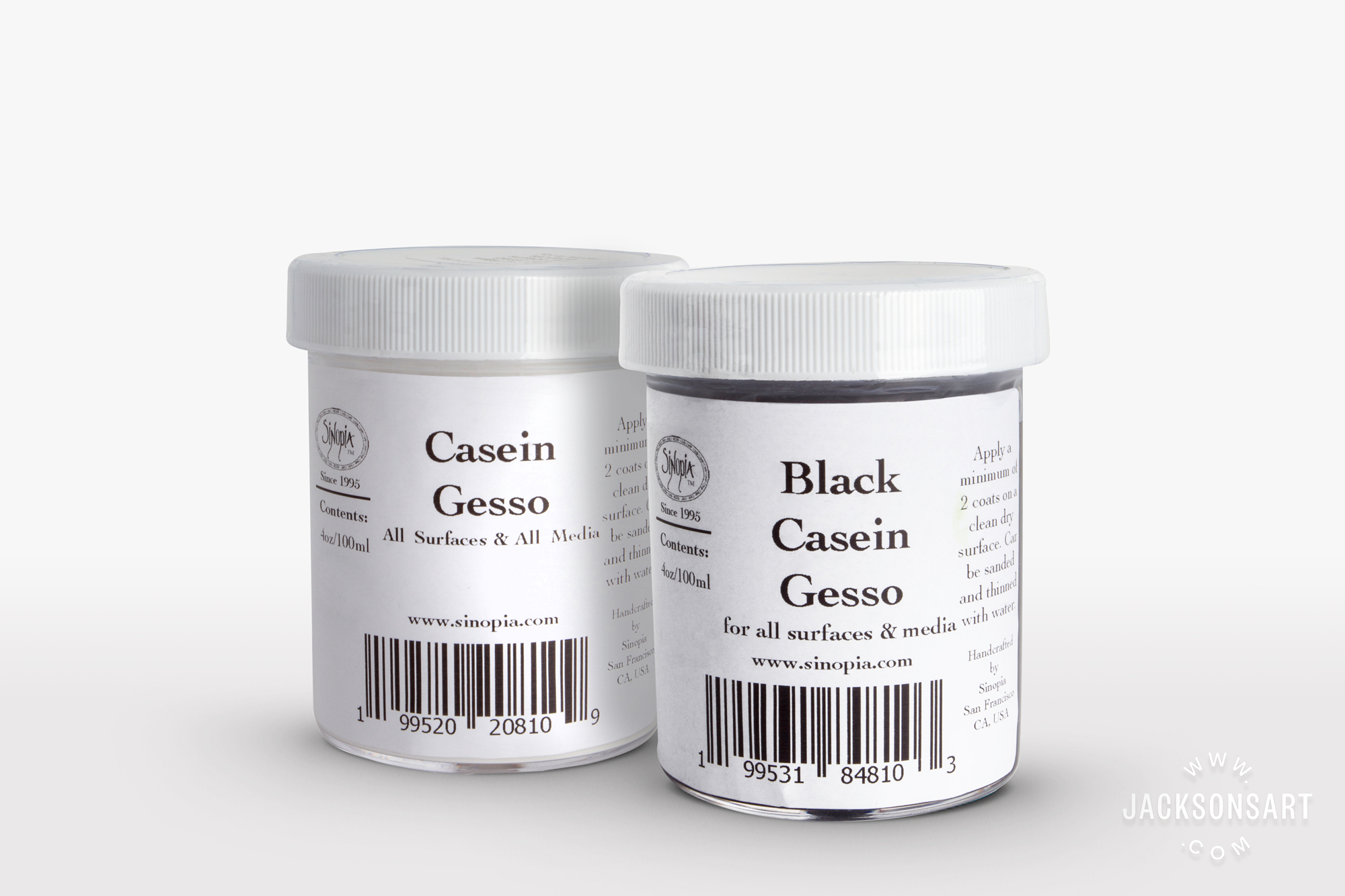
Casein Gesso
Sinopia Casein Gesso is very absorbent and is the adjacent best thing to genuine gesso. You use it straight from the jar at room temperature. It is made with milk protein (casein) which is a binder in casein paints. It contains a small corporeality of linseed oil that has been emulsified and so it can exist thinned and cleaned upwardly with h2o. Only the oil content is actually quite minimal, only enough to brand the gesso flexible and water insoluble after it has dried and cured – because it is minimal they say that the surface doesn't demand to exist sized first to protect it from the oil.
One time the gesso is practical it dries to the touch in a short corporeality of time and then you can employ the second coat the same day when the offset is touch on dry out, merely no more than two coats a day. While the surface is stable plenty for one additional layer, the oil content has to cure enough for subsequent layers to be applied. Because the recipe includes a linseed oil emulsion it volition accept four or 5 days for the surface to cure and get water insoluble. If you lot are working with aqueous launder techniques, which soak the surface with water, so yous should expect for a complete cure. With less h2o or with oil techniques, the surface can be painted on after a few days.
Unlike 18-carat gesso you are non limited to rigid surfaces, though it should only exist practical to smaller canvases and pieces of paper and they should never exist rolled after the surface has been painted. Nosotros take had encaustic and egg tempera artists requite it good reviews for absorbency.
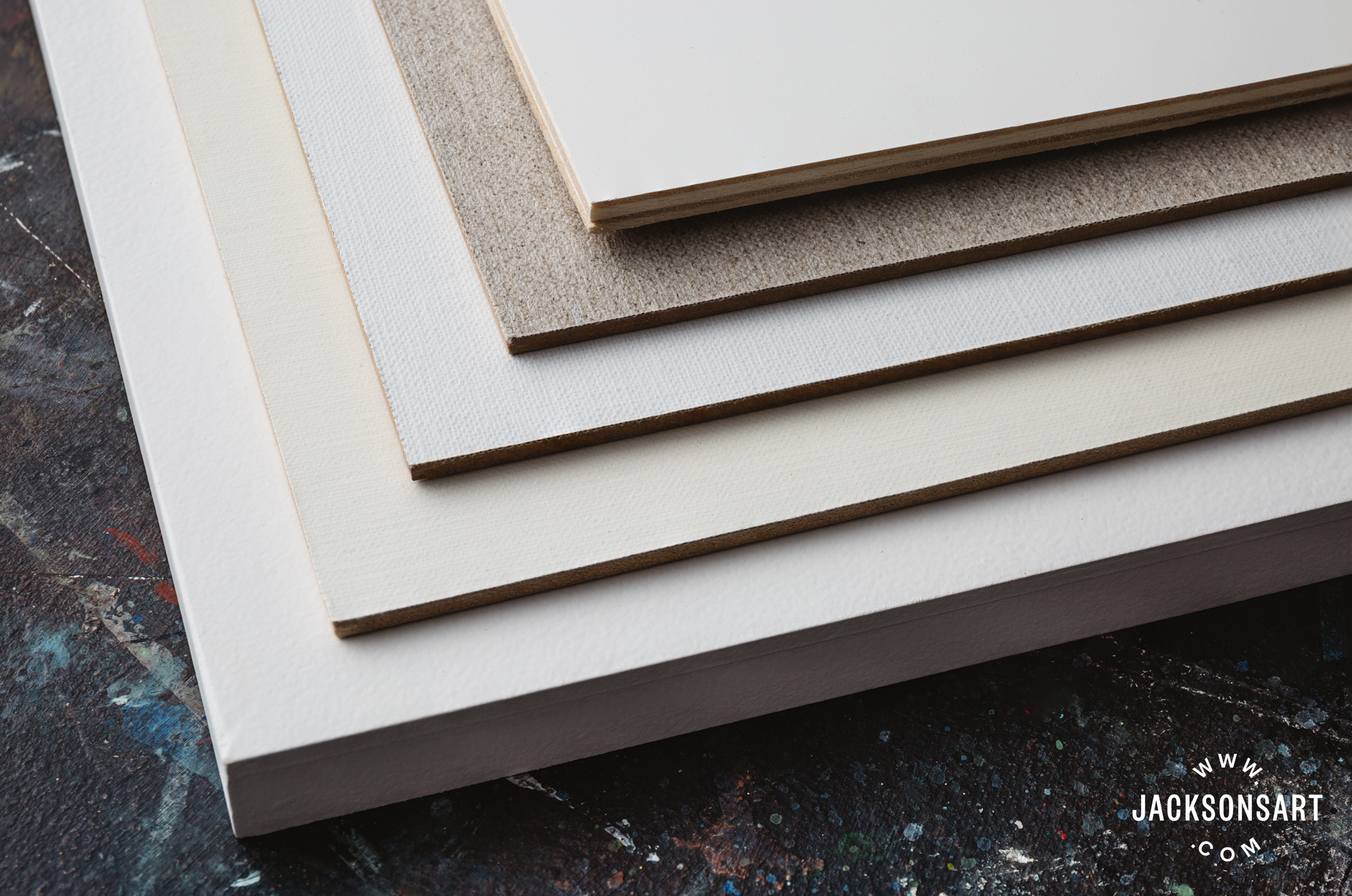
Panels with different ready-prepared primers/grounds – top to bottom: Belle Arti gesso panel (acrylic primer), clear sized linen (RSG), universal primed linen (acrylic primer), oil primed linen and a universal primed cradled panel (acrylic primer).
Grounds
A ground is the surface that your paint comes in contact with. It'southward the part that y'all experience with your brush. You may want it to be hard or soft, polish or textured, absorbent or non-absorptive, coloured or white. The characteristics of your ground affect the way the paint handles, how easily information technology moves on the surface and how chop-chop it dries. Many acrylic texture pastes such equally fibre paste, modelling paste or atomic number 26 oxide, can be used every bit painting or drawing grounds. Grounds are of particular interest to oil painters for whom in that location is a wider selection of fix-prepared acrylic grounds, oil grounds, alkyd grounds, casein grounds (a mixture of oil, alkyd and casein, which is a milk protein pigment binder) and others. In that location are also grounds for oil painting which are generally made by the artist merely before applying, like 18-carat gesso, chalk ground, half-chalk ground, egg-linseed oil emulsion, and others, the recipes for which can be found in books on traditional oil painting or online. Grounds designed for pastel painting tin be practical to a sized canvass for utilise with oil pigment and some painters like the gritty texture.
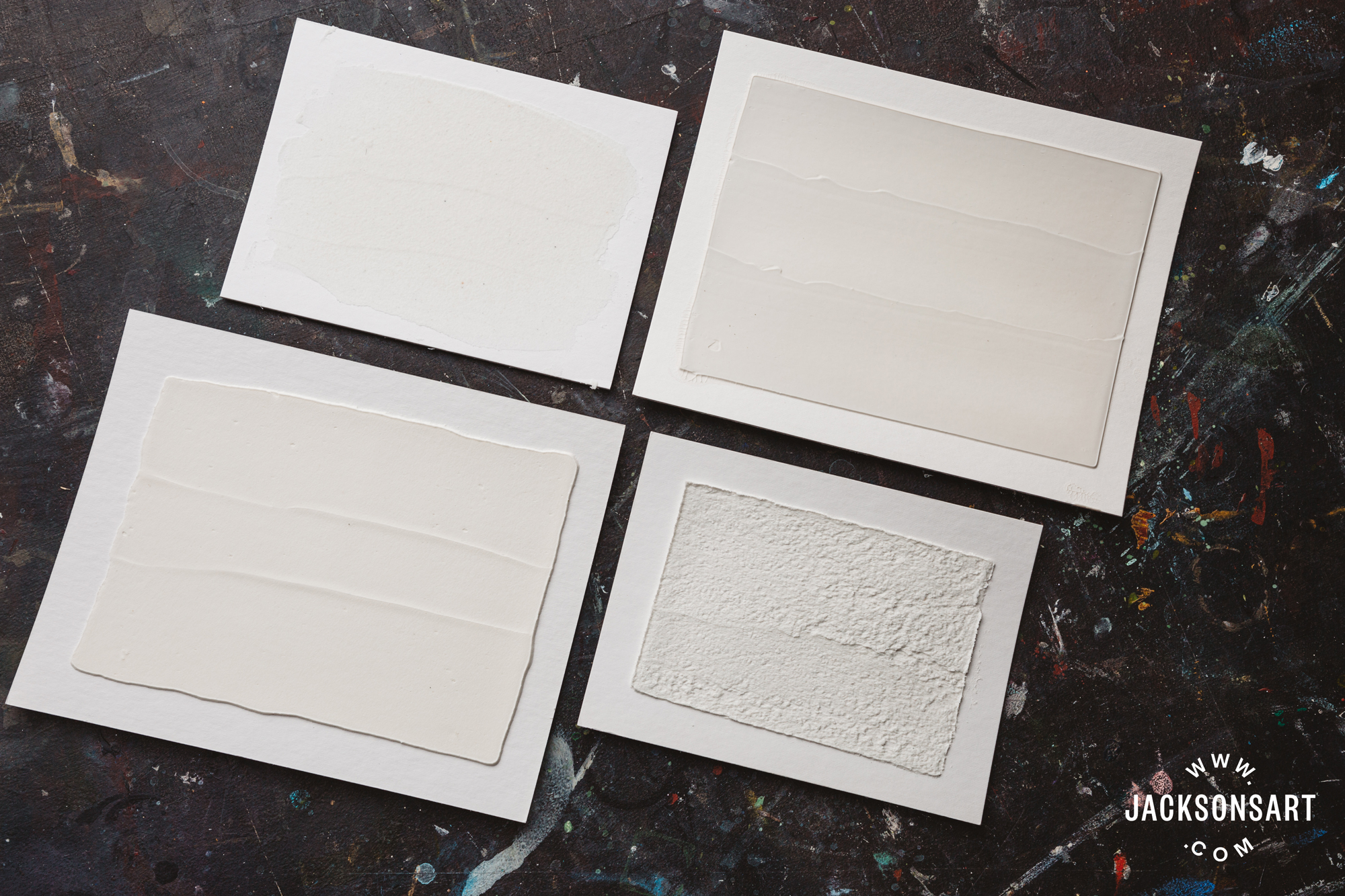
iv Gilded texture pastes used every bit grounds- clockwise from top left: Coarse Molding Paste, Molding Paste, Fibre Paste and Light Moulding Paste.

Oil grounds.
Oil Ground
Oil primer or oil basis is oil paint with added chalk to give some absorbency and some tooth for the oil pigment to grab onto. It must exist applied over sizing considering applying oil primer is the same as applying oil paint, so the fibres need to be sealed from the oil. A stretched canvas, a canvas console, or primed sail by the metre, that has an oil basis will oft exist labelled as 'oil primed canvas'. Pots of oil basis may be called oil primer, oil ground, alkyd ground for oil, alkyd primer, or thixotropic oil primer. Thixotropic is the quality of some materials to exist thick while they are settled but flow in one case they are stirred, like jam, motor oil and alkyd mediums. Alkyd resins are created past modifying polyester resins with fatty acids. Information technology's the aforementioned fatty acids from the drying oils that are detrimental to cellulose which means you all the same need to size the canvass or paper to create a bulwark so it can't penetrate to the fibres. Alkyd usually dries faster than oil paint and then a fast-drying oil ground is normally made with alkyd. A sail with an oil basis unremarkably appears yellow because of the dark yellowing of the linseed oil content. This doesn't affect the painting if the unabridged canvas is covered with paint so that the canvas isn't bare anywhere. Best practice is to apply oil or alkyd grounds on a rigid support to foreclose slap-up, and conservators generally recommend all oil painting be done on rigid supports, anyway.
Since we are located in the UK where atomic number 82 is prohibited, we do not stock any lead oil primers. But I thought I would mention that they exist. A lead oil footing uses atomic number 82 white pigment instead of titanium white, which affects the drying fourth dimension and opacity.
For some time it was idea that oil painting on height of acrylic paint or an acrylic ground was not all-time exercise because the oil paint would not adhere well. This concern has been pretty much discounted these days so long as the acrylic is absorbent enough for the oil to penetrate into it sufficiently to physically merge with it, which is the case of all artist-quality acrylic grounds, and acrylic paint is quite soft and porous.

Simply a few of the absorbent/watercolour grounds available. Some come in colours or different "paper" textures.
Absorbent Basis
Acrylic paint can be used thickly to look similar to oil paint or in a more fluid manner similar to watercolour. If you use acrylics in a staining or washy way, you may detect an Absorbent Basis or watercolour basis interesting to piece of work on. It'due south a bit like painting liquid paper onto your canvass or panel and tin go on meridian of a prepare-made, universally primed canvass to give it a newspaper-like surface. If y'all are using information technology for oil paint be certain that the surface is well-sealed before applying the absorbent/watercolour ground. Some brands require an acrylic primer/gesso underneath and some don't, so check the instructions. We accept an article that covers these: Painting with Watercolour on Canvass: Choosing the best Watercolour Ground
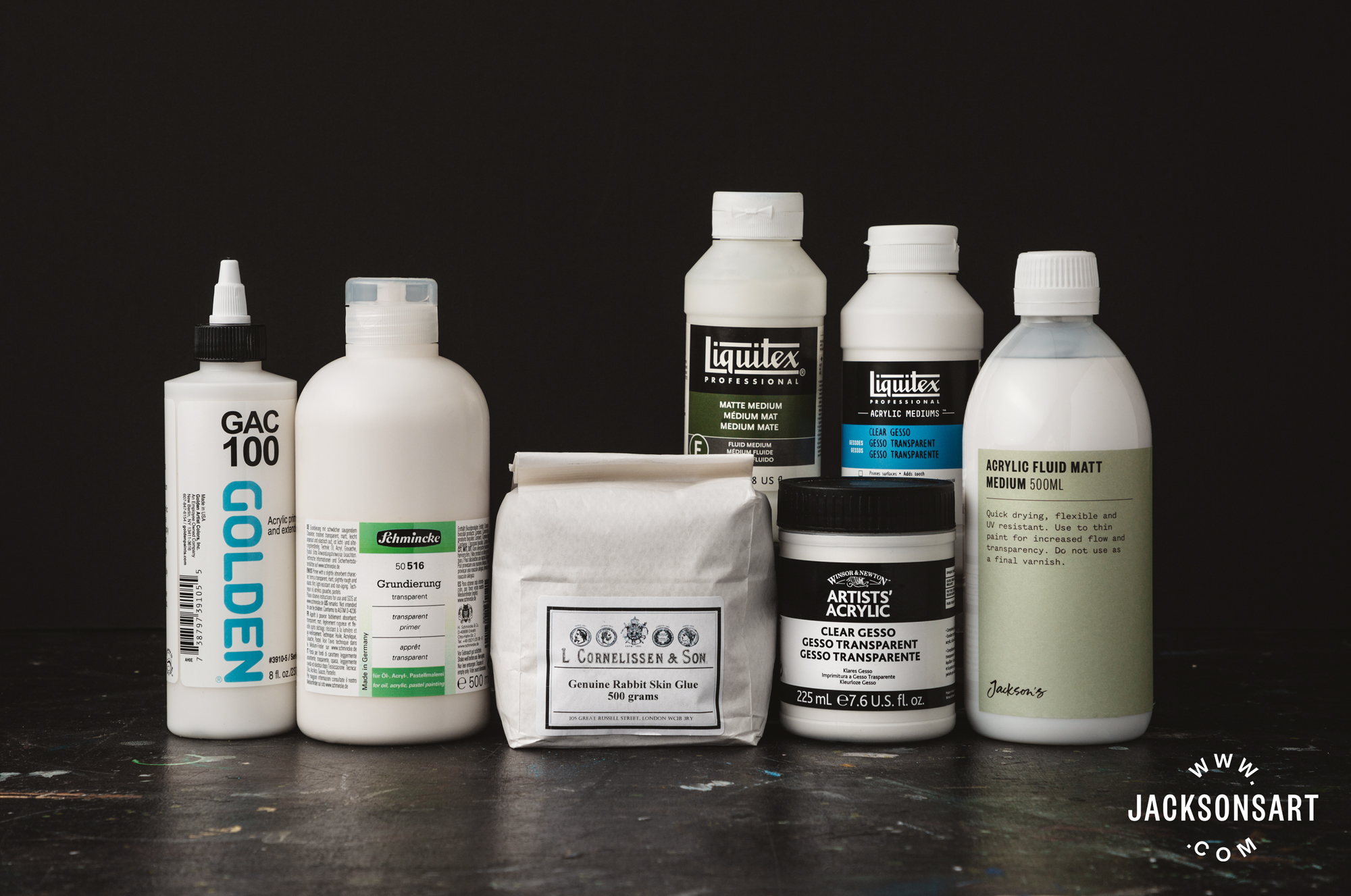
Clear/transparent grounds.
Clear Grounds
If yous wish to see the surface of the canvas, paper or forest instead of roofing it with a white layer yous tin can apply a clear ground. This could be a few coats of matt medium, rabbit skin mucilage or a "transparent gesso" or "clear primer". If y'all are preparing canvas or paper for oil paint you will need enough coats to be both the size and the basis. Exist enlightened that a few coats of "clear gesso" usually creates a white haze from a build upward of the fabric that was used to give it some molar, then these are not usually actually clear. One way to reduce this effect is to seal the canvas with something truly clear like polymer medium earlier using anything that contains toothy material or matting agents and simply use one of those for the final layer. This means there is less of the cloudy stuff congenital up and besides since the canvass is now sealed, the articulate part of the articulate gesso doesn't soak in leaving the matting material more full-bodied on the surface.
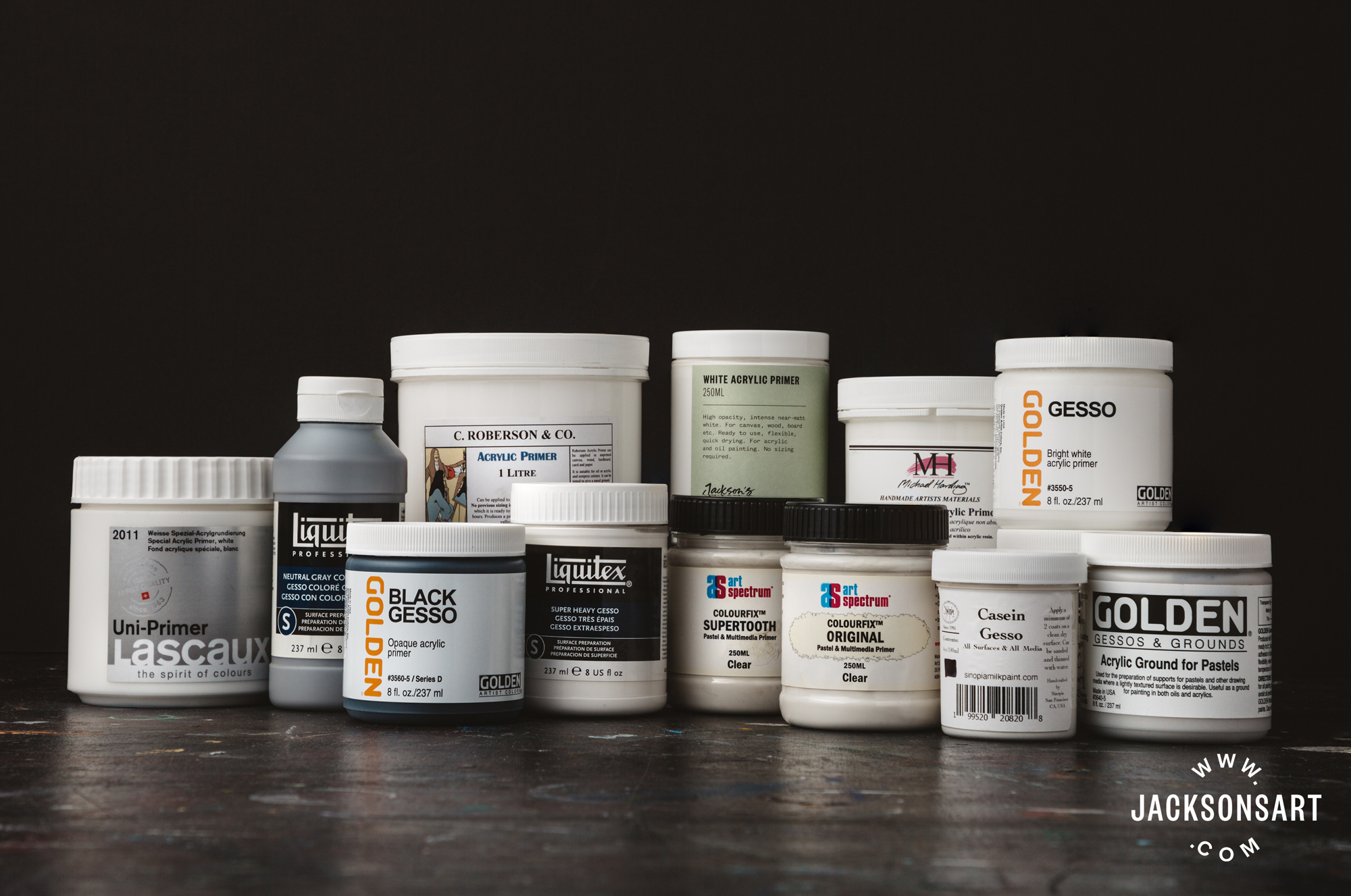
Some acrylic dispersion grounds (acrylic primers/gessos).
Acrylic Dispersion Ground is an All-In-One Product
Acrylic footing (or acrylic gesso or acrylic primer) can fulfil all of these roles at the same fourth dimension – it seals, primes and provides a ground. You tin simply apply two or three thin coats, await two days for it to cure if you are using acrylics and iii days for oil painting, and y'all are fix to paint. Simply some artists prefer to add together a size anyhow earlier they utilize acrylic primer, to reduce Support Induced Discolouration (SID) where sometimes the white ground gets yellow stains in it past drawing up colour from the canvas, wood or stretcher bars while it is wet. This is by and large of business to painters who will be staining the canvas with thin transparent layers where the slight discolouration might show through. And even though it tin act as size, primer and ground some painters only utilize acrylic primer for the sizing and priming qualities but do not like the ground information technology provides, finding it too absorptive or as well toothy, then they might mix some matt medium into the ground before applying it to reduce absorbency, or utilize an oil footing on top of the acrylic primer after it's dry. If you desire a more absorptive surface yous can mix modelling paste or actress whiting or other chalk or marble dust into the ground before applying it. You can mix an acrylic texture paste such as pumice paste in with the acrylic primer/basis before applying it if you desire more than tooth, or mix in pumice powder. If you take a stretched canvas that is universally primed (pregnant you can paint on information technology with oil or acrylic paint), there is an acrylic primer on information technology that has sized the surface, so you tin add any custom ground on top of the provided priming, to give you the exact surface you desire to paint on. Some examples are oil ground, absorbent ground, pastel primer and many other possibilities.
An acrylic footing is the usual selection for preparing watercolour paper for acrylic pigment or oil paint. It will add together body to the support and so that the amount of paint isn't heavier than the amount of paper. 2 coats is usually plenty to seal the paper from the dissentious effects of the oil for oil painting. See Everything You lot Need to Know Well-nigh Oil Painting Newspaper for more than information on priming paper.
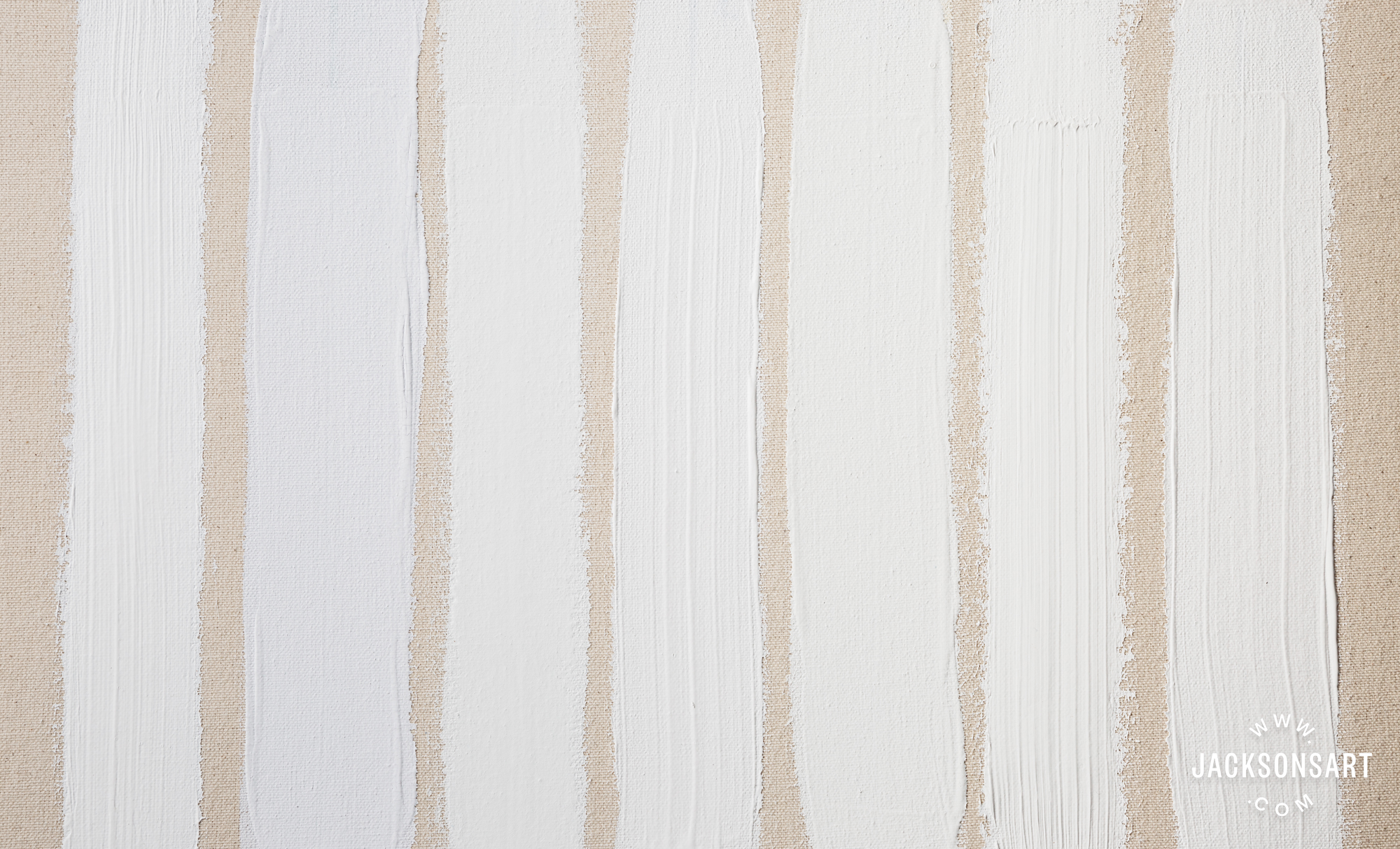
Acrylic primer/grounds -left to right: Gilded heavy torso acrylic paint Titanium White, AV Gesso Acrylic Primer, R&F Encaustic Gesso, Daler-Rowney Gesso Primer white, Winsor & Newton Artists Acrylic White Gesso, Liquitex Super Heavy Gesso, Roberson Acrylic Primer.
Every brand of acrylic primer has a different formula and some are better at existence sanded smoothen, some are less or more than absorbent, some crack more when applied thickly or stale too quickly, some are non very flexible and state they are for rigid surfaces only, non stretched canvass or paper. Some brands make a variety of types, calling their less absorbent version 'acrylic primer' and calling their more than absorbent version with more whiting (chalk) added 'acrylic gesso'. Michael Harding makes one for oil painters that is non-absorbent. All acrylic primer/grounds can be tinted with a lilliputian acrylic paint earlier applying, if desired. Be aware that inexpensive primers (which we don't sell) may non adhere very well to the back up and may pare off later on. Just to annotation: Acrylic Primer is chosen 'acrylic' because information technology is made of acrylic, not because it is for utilize just with acrylic pigment.
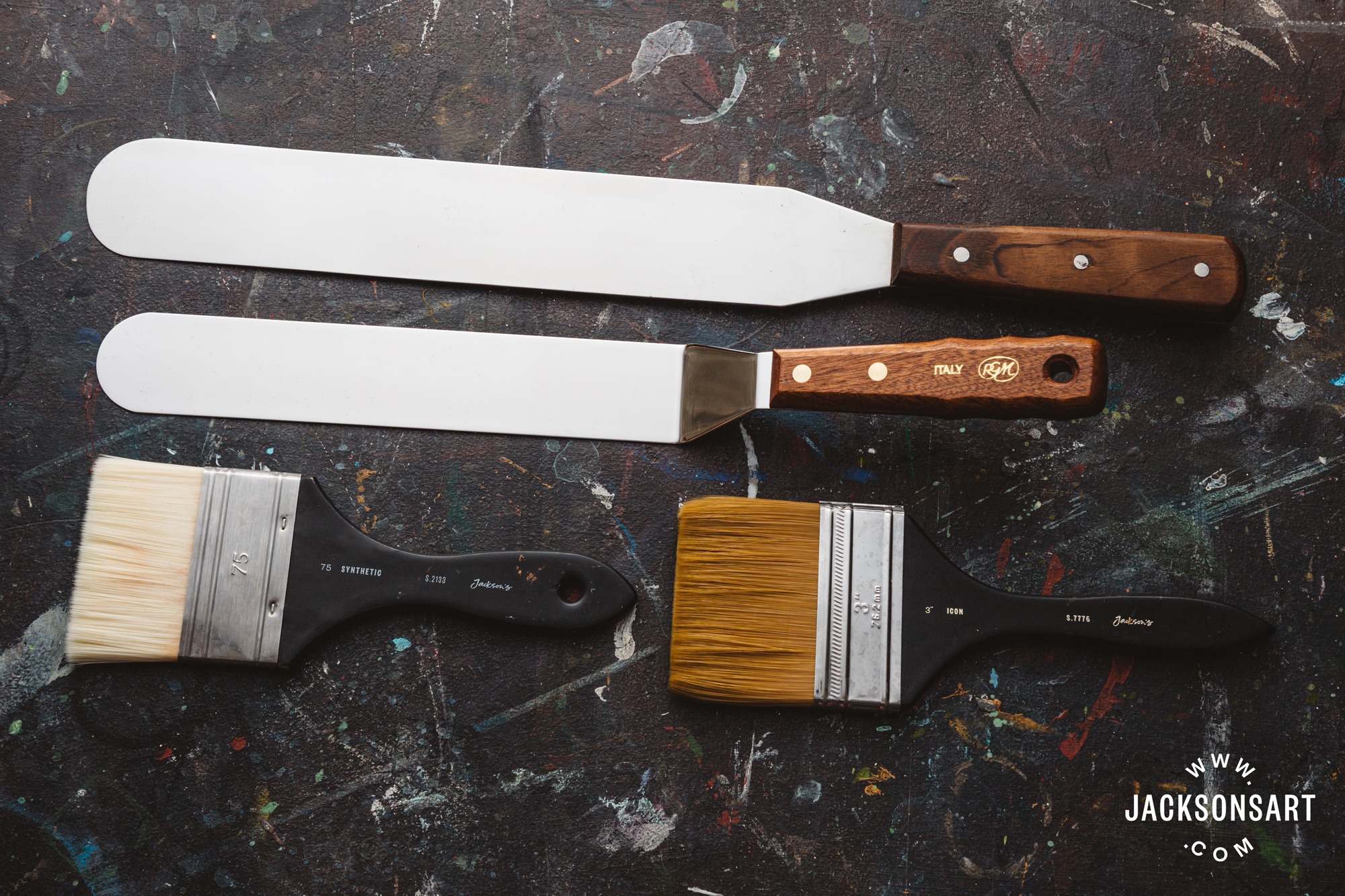
A broad soft brush alone or followed by a big palette knife used similar a squeegee, are dandy for applying grounds.
Applying a Size or Ground
A size is more often than not brushed on with a wide, flat brush or scraped on with a duster, palette pocketknife or spatula. Scraping may help to fill the holes of a more loosely woven canvas. The get-go coat is worked into the fibres a bit. You apply 2 – 4 coats to seal the support from oil paint, or one to seal it from Support Induced Discolouration (SID). Each coat can be practical as soon every bit the previous is touch dry.
A ground can be applied with a brush, palette pocketknife or paint roller. Each coat can be applied equally soon every bit the previous is affect dry out.
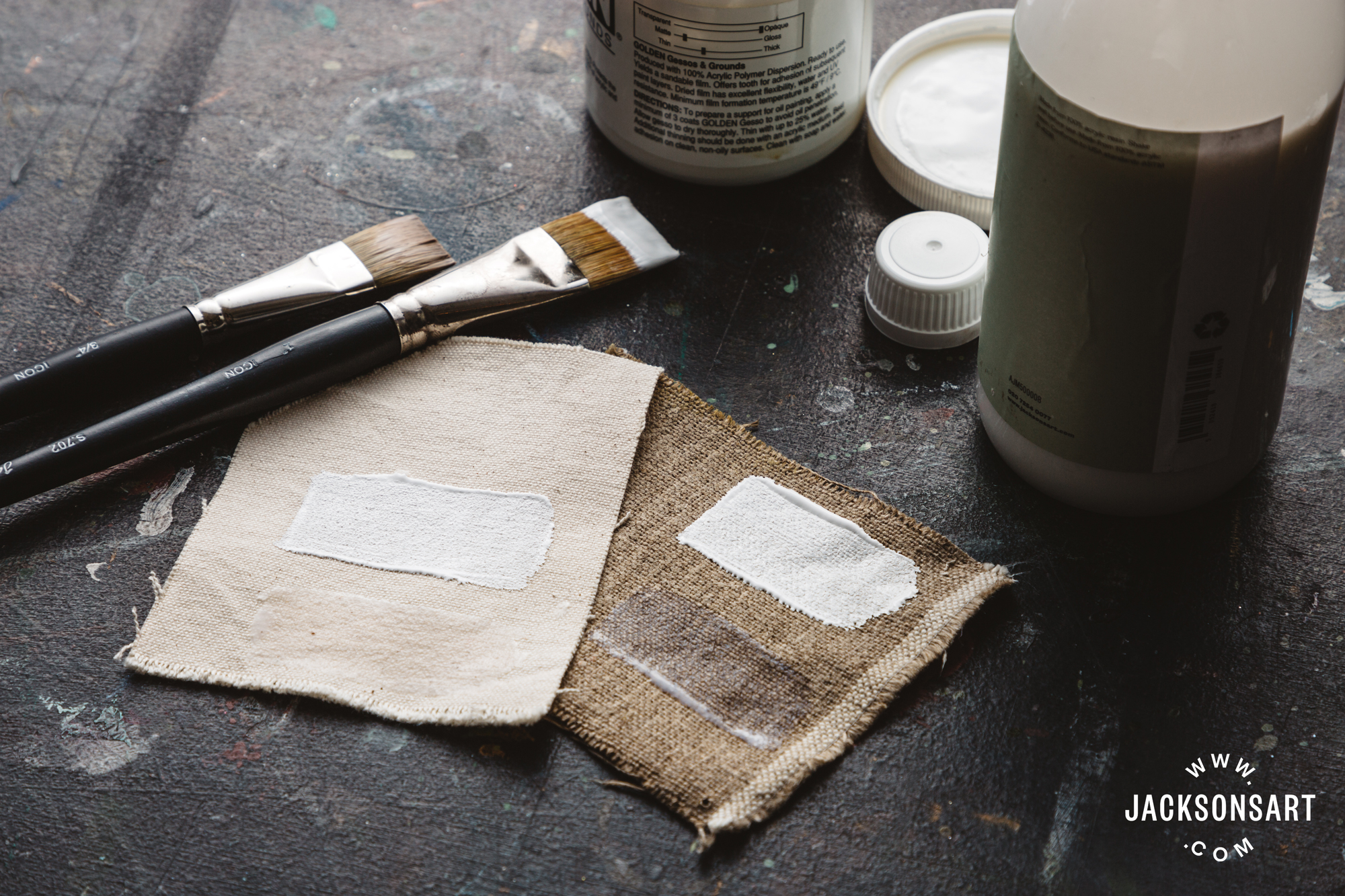
Testing different acrylic primers on linen and cotton wool canvass. Shown here moisture.
Acrylic footing differs in thickness, opacity and grittiness, depending on the manufacturer. It is usually too thick to use straight out of the bucket and should be diluted with a pocket-size amount of h2o (up to 10%) until it is the consistency of heavy cream. Most primers accept instructions that suggest yous that it is meliorate to utilise three thin coats rather than one thick coat – a very thick coat may crack equally it dries. For oil painting, the first coat is oftentimes scrubbed into the weave of the raw canvas in circular motions to be certain that it is well sealed, since information technology is acting as a size as well equally a ground. So subsequent coats are practical in alternating directions across the sheet. An acrylic ground tin can be lightly sanded betwixt layers if you wish information technology to be particularly smooth (take care to article of clothing a grit mask).
3 means to prepare your surface for oil painting
On linen, cotton wool or paper you can seal the surface to prevent penetration from oil paint and have a good footing to paint on, in one of these three ways:
1. Utilize a clear size and ground, usually 2 to iv coats of acrylic medium or rabbit skin glue, which will be your concluding surface. Takes one day to dry. You would practise this if you wanted to see the surface because y'all will exist leaving part of the brown linen to show, for case, or yous like painting on a mid-tone. The acrylic medium provides a polish surface that is not very absorbent, and then you can wipe back oil pigment as function of the painting process. The RSG provides a smooth surface that the pigment settles into.
2. Utilize a clear size to seal the fibres and then an oil ground. Recall, an oil footing is essentially oil paint, so it volition take the time of oil paint to dry and will need to cure for a calendar week or two. You would use this surface if you lot like the feeling of the brush on an oil-primed surface. There is just the correct corporeality of brush drag and it is not every bit absorptive equally acrylic primer so you may have fewer sunk-in areas where the oil has captivated out of the paint into the primer, and it is white if you want that surface to reverberate back through your transparent colours.
three. Acrylic primer/ground, normally a offset coat thinned with 10% water, then two more than coats, practical when the previous is touch dry, and so all coats can exist done in i solar day. So await iii days for it to cure, then the oil volition bond to it properly. You lot would employ this if you lot like an absorptive surface, you tin't look for 1 to 2 weeks for an oil ground to cure, prefer the ease of i product that does the job of both sizing and ground, and that is h2o-mixable. If you wish to utilize an acrylic primer but would like the "faster" feel of oil primer (more than slippery, less absorbent, slower drying), then you can wipe linseed oil over the whole surface and wipe information technology back off, leaving the barest film and and then paint onto this, wet or dry. The absorbency of acrylic primers varies a lot and Michael Harding makes one for oil painters that is non-absorptive.
If you wish to use genuine gesso for oil painting you will need to utilize it to a rigid panel. You lot can read more virtually that in Rabbit Skin Glue: Grooming, Uses and Alternatives.
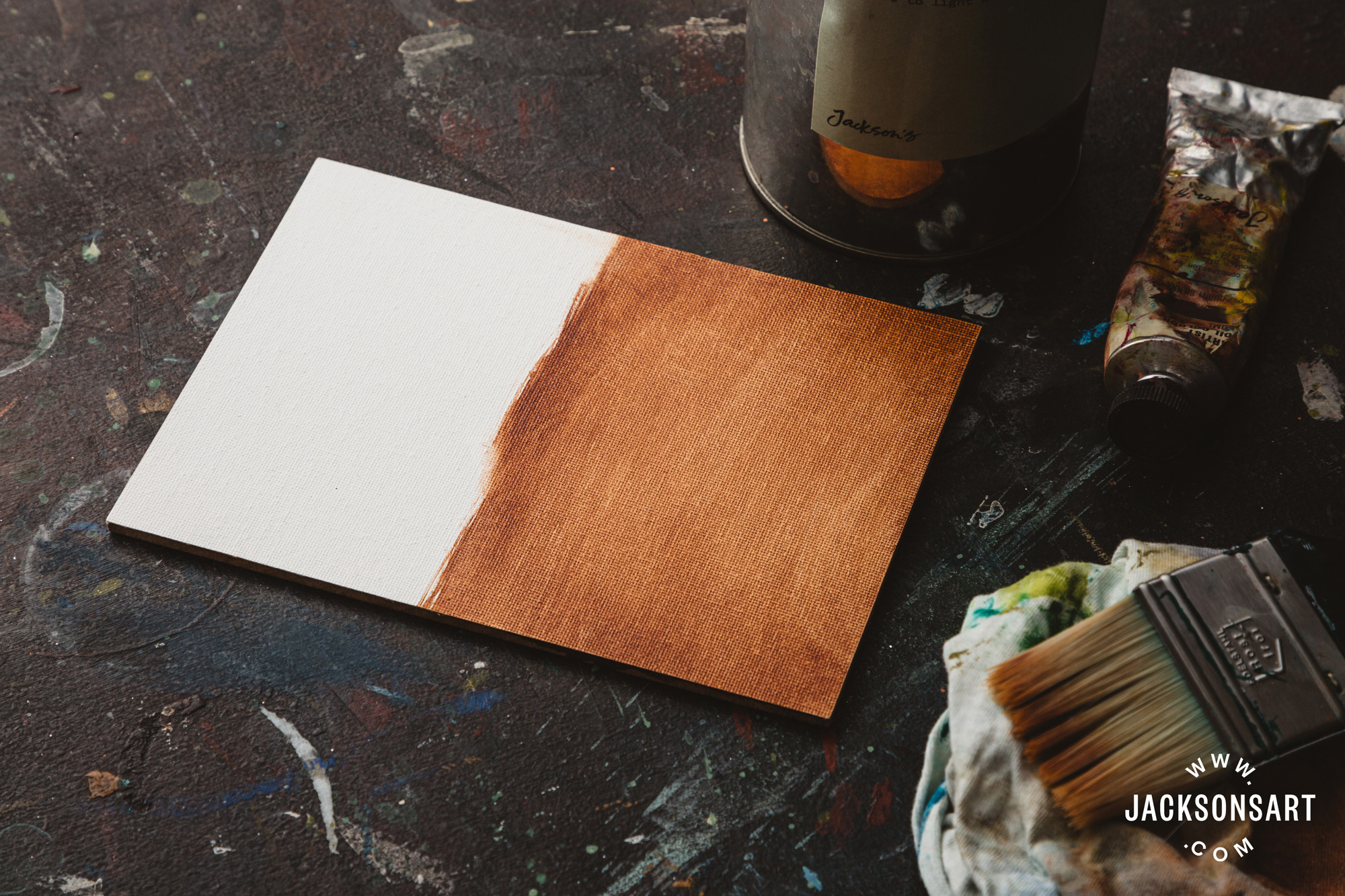
Toning a ground with a mixture of burnt sienna oil pigment and turpentine, and and so wiping most of it off with a rag allows the white of the canvass to show through the sparse layer and give a little glow to the colour, also every bit insuring it will be dry out plenty to paint on the next twenty-four hours.
Toning the Ground
Painting on a white canvas can crusade you to pigment in colours lighter or brighter than you intended, and then yous and so need to suit your colours later on you have more of the white covered and you lot tin can come across the actual colours better next to each other. This is 1 of the reasons that many painters adopt a wooden palette. To avoid mis-judging the colours or values on the white, some artists apply a heart value on the whole canvass before they start, this toning of the canvas too prevents unwanted bits of white canvas showing through your brushwork and you can leave bits of the tone colour showing for added liveliness. Sometimes a eye value, toned basis is used to allow the painter to only need to add the calorie-free colours and the nighttime colours, leaving the toned office unpainted as the middle value. In keeping with the fatty-over-lean rule, toning is usually washed with a lean mixture, the leanest mixture of the painting. Commonly a thin wash of just a bit of paint in a lot of solvent is wiped over the entire surface with a rag. A warm, middle tone like burnt sienna might be used to add together warmth to a painting that will be equanimous of mostly cool colours. Using burnt umber would be toning with a more neutral colour. Information technology is traditional to use globe colours because they dry faster than other colours and you tin normally paint on the canvas the adjacent day. I oftentimes scrape leftover pigment off my palette and use information technology to tone a basis, which doesn't dry out as fast considering information technology often has some tiresome drying colours in it like titanium white. You can also experiment with applying blackness and coloured acrylic primer/grounds.
An Acrylic Exception – Staining Canvas with Acrylics and Flow Release
If you desire to use a staining method with acrylics on raw sail there is another way to become around the beading up that you would go with a watery acrylic mixture on raw canvas. Skip both sizing and a footing and instead add a small corporeality of flow release wetting agent to the pigment which decreases the surface tension and allows it to menstruum and be captivated by the raw canvas. Because acrylic doesn't contain the oil that damages the cellulose fibres you don't need to be concerned with protecting the canvas from the acrylic, and then sizing isn't necessary. Please note that these are concentrates and you volition add together xx parts water to create flow release water that you then use with your paints.
Liquitex Flow Aid
Golden Flow Release
Surface Preparation Materials at Jackson's
- Size
- Acrylic Ground
- Oil Basis
- Casein Footing
- Blackness and Coloured Acrylic Basis
- Materials for 18-carat gesso
- Sheet Department
- Glue-sized canvas
- Wooden panels
- Wide flat brushes
- Extra large palette knives
Read some of our other articles well-nigh canvas and priming
- Choosing the Right Sail for Your Painting
- The Right Sheet: choosing stretcher bars, canvas and priming
- Don't Be a Foursquare – Preparing Circular Painting Panels
- Making a Canvass Painting Console
- Rabbit Skin Glue: Grooming, Uses and Alternatives
- Lora Irish potato: Encaustic and Sinopia Casein Gesso
- Everything You Need to Know About Oil Painting Paper
- Using Sinopia Chalk Ground and Sinopia Casein Gesso for Egg Tempera
Source: https://www.jacksonsart.com/blog/2021/08/23/size-primer-gesso-and-ground-explained/
0 Response to "what can cause a layer of glass beads to cover the ground"
Post a Comment